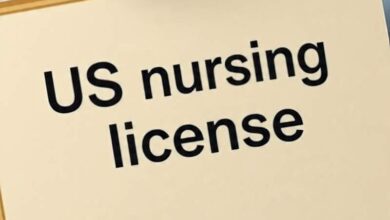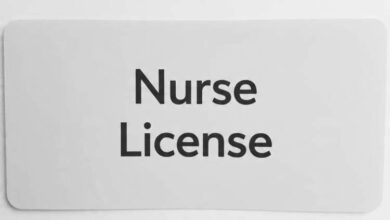Proven Steps: How to Transfer a Nursing License to Another State (Endorsement Process 2025)

How to Transfer a Nursing License to Another State (Endorsement Process 2025)
Are you a nurse planning to move and wondering how to transfer a nursing license to another state in 2025? The good news is you don’t have to start from scratch or retake the NCLEX. Instead, you can go through the nursing license endorsement process, which allows you to use your existing license to apply for recognition in a new state.

Whether you’re relocating for a job, family reasons, or simply exploring new opportunities, understanding how license transfer works is the first step to continuing your nursing career without delays.
In this guide, we’ll break down the endorsement process in 2025, including what it means, the documents you’ll need, timelines to expect, and tips to avoid common mistakes. You’ll also learn how the Nurse Licensure Compact (NLC) can simplify things if your state is a member. By the end, you’ll have a clear roadmap to ensure a smooth transition, so you can focus less on paperwork and more on caring for your patients.
What Is Nursing License Endorsement?
Before you begin the transfer, it’s important to understand what nursing license endorsement really means. Endorsement is the process that allows a nurse who already holds an active license in one U.S. state to obtain permission to practice in another state—without having to retake the NCLEX. Instead of starting all over, you “endorse” your current license, which proves that you already meet professional standards and are qualified to work as a nurse.
For example, if you are licensed in California and receive a job offer in Florida, you don’t need to sit for another exam. You simply apply for endorsement with the Florida Board of Nursing, submit your credentials, and fulfill any state-specific requirements.
The typical endorsement process involves:
-
Submitting an online application through the new state’s Board of Nursing.
-
Verifying your current license through Nursys or directly with your state of original licensure.
-
Completing any continuing education (CEU) requirements specific to the new state.
-
Paying application and background check fees (which vary by state).
-
Waiting for processing (ranging from a few weeks to a few months, depending on the state).
In short, endorsement makes relocation possible without unnecessary testing, ensuring your career continues smoothly as you move between states.
Proven Steps: US States That Don’t Require CGFNS for Foreign Nurses (2025 Update)
Step-by-Step Guide: How to Transfer a Nursing License to Another State in 2025
Moving to another state as a nurse in 2025 doesn’t have to feel overwhelming. With most states now offering online applications, electronic payments, and streamlined Nursys license verification, the endorsement process is faster and more organized than in previous years. Whether you’re relocating for family, a new job, or career advancement, knowing exactly what to expect will save you time and stress.

Here’s a clear step-by-step guide to transferring your nursing license smoothly in 2025:
1. Check State Requirements
The first step is always research. Every state has its own Board of Nursing (BON) with unique rules, fees, and timelines. Start by visiting the official BON website of the state where you plan to practice. Key things to check include:
-
Eligibility requirements (some states require a Social Security number or proof of residency).
-
Continuing Education (CEU) requirements (a few states ask for specific training such as child abuse reporting or opioid awareness).
-
Processing timelines (some states process in 2–4 weeks, while others can take up to 3 months).
Bookmark your new BON’s “Endorsement/License Transfer” page and refer back often, as rules can change yearly.
2. Submit Your Online Application
Almost all states now have digital licensing portals, making the process much faster. When completing the form:
-
Use your legal name as it appears on your current license and identification documents.
-
Double-check every field before submitting; even small errors (like misspelled addresses) can cause delays.
-
Upload clear, legible copies of required documents (driver’s license, nursing diploma, CEU certificates, etc.).
Incomplete applications are one of the top reasons endorsement requests get delayed—take your time to get it right.
3. Verify Your Current License
To prove your license is active and in good standing, most states use Nursys License Verification. This system electronically confirms your credentials and sends them directly to the new state’s BON.
-
If your state participates in Nursys, simply request verification and pay a small fee (usually $30).
-
If your state doesn’t use Nursys, you’ll need to request that your original BON send verification directly to your new BON, which can take longer.
4. Complete a Background Check
Nearly every state requires a criminal background check as part of endorsement. This often includes:
-
Fingerprinting (electronic or ink-based).
-
State and FBI checks.
Since background checks can take several weeks, it’s best to complete this step early. Delaying fingerprints is one of the most common causes of slow application approvals.
5. Submit Continuing Education (if required)
Some states require proof of continuing education hours (CEUs) before granting a license by endorsement. For example:
-
Florida often requires CEUs in human trafficking awareness.
-
Texas requires jurisprudence exams.
-
California asks for child abuse reporting training.
Keep digital CEU certificates in an organized folder for easy upload when applying.
6. Pay Application Fees
Expect fees to range from $100–$300, depending on the state. Many BONs accept credit cards or electronic transfers through their portals. Always:
-
Save your confirmation receipt.
-
Verify that your payment processed successfully.
-
Be prepared for additional fees (background checks, fingerprinting, Nursys verification).
7. Apply for a Temporary License (if available)
Several states offer temporary nursing permits, usually valid for 30–120 days. These allow you to start working while waiting for your permanent endorsement to finalize.
If you already have a job lined up, applying for a temporary permit can make the transition much smoother.
8. Track Your Application Status
Most BONs have online status trackers where you can log in and monitor progress. Regularly checking ensures that:
-
You see if documents are missing.
-
You’re notified immediately if additional steps are required.
-
You can follow up with the BON if your application stalls.
Factors That Can Affect Nursing License Endorsement Processing Time

Even though the endorsement process in 2025 has become more efficient, several factors can influence how quickly your new license is approved. Understanding these variables will help you plan ahead and avoid unnecessary delays.
1. State Board of Nursing Workload
Some states process applications within 2–4 weeks, while others may take 2–3 months due to higher demand or staffing shortages. Applying early is key.
2. Background Check Requirements
If a state requires fingerprinting, FBI checks, or state-specific screenings, this step can add extra weeks to your application timeline. Delays often happen when fingerprints are smudged or incomplete.
3. Continuing Education (CEU) Obligations
Certain states require proof of specific CEUs—such as opioid awareness, human trafficking, or cultural competency training—before granting endorsement. Missing or outdated CEU certificates can slow down approval.
4. Errors in the Application
Small mistakes like a misspelled name, outdated address, or incomplete employment history are among the most common causes of processing delays. Always double-check before submitting.
5. Nursys vs. Non-Nursys States
If your original state and new state both use Nursys verification, your license transfer is generally faster. However, if your state is non-Nursys, manual verification by mail may extend the timeline.
6. Temporary License Availability
States offering temporary permits allow nurses to start working almost immediately, even while their permanent license is being processed. Lack of this option could mean waiting longer before employment.
7. Fee Payments & Processing Errors
Unpaid or declined payments can stall your application without notice. Always confirm that your transaction has been successfully processed and save your receipt.
By being aware of these factors, you can set realistic expectations and take proactive steps to speed up your license transfer in 2025.
Easiest States for Nursing License Endorsement in 2025
Not all states handle nursing license endorsements the same way. Some are known for their quick processing times, minimal requirements, and streamlined online systems, making them much easier for nurses who want to transfer. In 2025, these states stand out as the most nurse-friendly for endorsements:
1. Texas
-
Average processing time: 2–4 weeks
-
Fully online application via the Texas BON portal
-
Accepts Nursys verification, making license checks fast
-
Offers temporary permits so you can begin working quickly
2. Arizona
-
Member of the Nurse Licensure Compact (NLC), which allows nurses with a compact license to practice in all compact states without extra applications
-
Simple background check process with electronic fingerprinting
-
Affordable fees compared to other states
3. Florida
-
Known for having a user-friendly online application system
-
Provides temporary licenses in as little as 2 weeks
-
Minimal CEU requirements for endorsement applicants
4. Idaho
-
Compact state with fast turnaround times (often under 3 weeks)
-
Very straightforward endorsement checklist with no additional exams
-
Lower fees than most other states
5. Missouri
-
Another NLC member state, making endorsement smoother for compact license holders
-
Offers temporary permits so you can work while waiting
-
Quick response times from the state BON
6. North Carolina
-
Endorsement applications processed in about 3–4 weeks
-
Streamlined use of Nursys verification
-
Clear, well-documented BON requirements for applicants
7. Virginia
-
Efficient online endorsement application system
-
Recognized for fast license approvals (some in under 30 days)
-
Member of the NLC, giving nurses even more mobility
Overall, NLC member states remain the easiest for license endorsement in 2025 since they allow nurses with a compact license to work across multiple states without repetitive applications. For non-compact states, the ones listed above provide some of the most efficient endorsement pathways.
💰 Average Nurse Salary in USA (2025) – State-by-State Guide: How Much Nurses Really Make
Step-by-Step Guide to Applying for Nursing License Endorsement in 2025

If you’re planning to transfer your nursing license to another state in 2025, following a clear process will help you avoid mistakes and delays. While each state board of nursing (BON) may have slightly different rules, most endorsement applications share the same key steps:
1. Confirm Eligibility
-
Make sure your current nursing license is active and in good standing.
-
Nurses with disciplinary actions may face additional review before endorsement.
2. Gather Required Documents
-
Valid government-issued ID (driver’s license or passport).
-
Social Security number (some states require it for verification).
-
Proof of education (nursing school transcripts, if requested).
-
Continuing Education (CEU) certificates, if required by the new state.
3. Complete the Online Application
-
Visit the new state’s Board of Nursing website.
-
Fill out the endorsement application form carefully.
-
Pay the application fee (usually $100–$200, varies by state).
4. Submit License Verification through Nursys
-
Most states use Nursys to confirm your existing license.
-
Log in to Nursys.com and request verification be sent to the new state.
5. Complete a Background Check & Fingerprinting
-
Many states require a criminal background check.
-
Some offer electronic fingerprinting for faster results.
6. Apply for a Temporary Permit (Optional but Recommended)
-
If available, apply for a temporary license so you can start working while your permanent license is being processed.
-
Temporary permits are often issued in 1–3 weeks.
7. Monitor Your Application Status
-
Use the state BON’s online portal to track progress.
-
Respond quickly if additional documents or corrections are requested.
8. Receive Your New License
-
Once approved, your permanent endorsement license will be issued.
-
Processing times vary, but in the easiest states, you may have it in as little as 2–4 weeks.
Start the process at least 2–3 months before your planned move or job start date. This gives you enough time for any delays in verification or background checks.
Conclusion: Make Your Nursing License Transfer Simple in 2025
Transferring your nursing license to another state in 2025 doesn’t have to be stressful or complicated. Thanks to the endorsement process, nurses no longer need to retake the NCLEX when moving to a new state. Instead, you can use your existing license to meet the new state’s requirements—saving both time and effort while allowing you to continue practicing without interruption.

The key to a smooth transfer lies in planning ahead. Submitting your application early, gathering all necessary documents, and confirming state-specific requirements can dramatically reduce processing delays. Using Nursys verification to validate your license, keeping CEU records handy, and applying for temporary permits (when available) are practical steps that put you ahead of the process.
For nurses in Nurse Licensure Compact (NLC) states, the transition is even simpler. A multistate license gives you the flexibility to work in all participating states without additional paperwork or waiting periods—making it an excellent option for travel nurses, those near state borders, or professionals considering multiple job offers across different states.
That said, it’s important to remember that each Board of Nursing sets its own rules. Fees, CEU requirements, and background checks may vary widely. Always verify the most up-to-date information directly from your new state’s official Board of Nursing website before applying to avoid unnecessary setbacks.
Whether you’re moving for higher pay, career advancement, family relocation, or new opportunities, understanding the endorsement process makes your transition smoother and less stressful. With the right preparation, you could secure your new license in as little as a few weeks—opening the door to fresh opportunities, professional growth, and a stronger future in nursing.
In short: be proactive, stay informed, and take advantage of available resources. Your nursing license transfer in 2025 can be a simple, well-managed step toward the next exciting chapter in your career.
Official Licensing & Verification Resources
-
NCSBN – Nursys License Verification
https://www.nursys.com/
(Official platform for verifying and transferring nursing licenses between states.) -
NCSBN – Nurse Licensure Compact (NLC) Information
https://www.ncsbn.org/nurse-licensure-compact.htm
(Details on compact states and how multistate licenses work in 2025.) -
NCSBN – Boards of Nursing Directory
https://www.ncsbn.org/boards-of-nursing.html
(Complete directory of all U.S. state Boards of Nursing websites, where nurses can find specific state endorsement rules.)
Background Checks & Fingerprinting
-
FBI – Identity History Summary Checks
https://www.fbi.gov/services/cjis/identity-history-summary-checks
(Official FBI site for fingerprinting and background checks required by many BONs.)
Examples of State BON Endorsement Pages
(You can link to a few high-traffic states as examples for your readers)
-
California Board of Registered Nursing – License by Endorsement
https://www.rn.ca.gov/applicants/lic-end.shtml -
Texas Board of Nursing – Endorsement Application
https://www.bon.texas.gov/licensure_endorsement.asp -
Florida Board of Nursing – License by Endorsement
https://floridasnursing.gov/licensing/licensed-practical-nurse-registered-nurse-endorsement/ -
New York State Education Department – RN & LPN Endorsement
http://www.op.nysed.gov/prof/nurse/nurseforms.htm
Frequently Asked Questions
No. If you already passed the NCLEX and hold an active license, you don’t need to retake the exam. You’ll simply apply for endorsement in your new state.
Processing times vary, but most states take 2–8 weeks depending on background checks, CEU verification, and how quickly documents are submitted.
Yes, many states issue temporary licenses or permits, allowing you to start working while your permanent license is being processed.
Application fees usually range between $100–$300, depending on the state. Additional costs may include fingerprinting, background checks, or CEU courses.
If you already hold a multistate license from another NLC state, you don’t need to apply for endorsement. You can practice freely in all compact states. However, if you establish permanent residency in a new compact state, you must transfer your primary license to that state.
Some states require proof of CEUs during the endorsement process, while others don’t. Always check your new state’s BON requirements in advance.
If your license is inactive, you may need to reactivate it before endorsement. If expired, you may need to meet additional renewal requirements before applying.





2 Comments